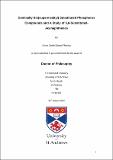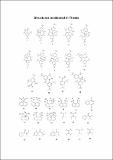Files in this item
Geminally bis(supermesityl) substituted phosphorus compounds and a study of 5,6-substituted-acenaphthenes
Item metadata
| dc.contributor.advisor | Kilian, Petr | |
| dc.contributor.author | Fleming, Conor Gareth Edward | |
| dc.coverage.spatial | xvi, 202 p. | en_US |
| dc.date.accessioned | 2013-05-27T10:03:55Z | |
| dc.date.available | 2013-05-27T10:03:55Z | |
| dc.date.issued | 2013-06-26 | |
| dc.identifier | uk.bl.ethos.572731 | |
| dc.identifier.uri | https://hdl.handle.net/10023/3553 | |
| dc.description.abstract | This thesis describes the effect of placing a phosphorus atom in a sterically strained environment with particular emphasis on the geminal disubstitution of two 2,4,6-tri-tert-butylphenyl (Mes*) groups on a single phosphorus centre and intramolecular sub-van der Waals interactions between peri-substituted atoms on naphthalene and acenaphthene. Chapter 2 outlines the reactive chemistry of a sterically encumbered phosphinic chloride (Mes*)₂P(=O)Cl, which was shown to have extremely low reactivity at the phosphorus centre. It has however, been demonstrated that synthetically significant transformations are possible. The phosphine oxide (Mes*)₂P(=O)H and a secondary phosphine Mes*(2,4-tBu₂C₆H₃)PH were obtained from the reduction of (Mes*)₂P(=O)Cl with hydridic reagents under forcing conditions. The corresponding phosphinite was acquired from the deprotonation of (Mes*)₂P(=O)H, which furnished very crowded tertiary phosphine oxides (Mes*)₂P(=O)R (R = Me and Et) on reactions with electrophiles. We have been unable to chlorinate or deprotonate Mes*(2,4-tBu₂C₆H₃)PH, however the reaction with elemental sulfur afforded the affiliated phosphine sulfide Mes*(2,4-[supercript(t)]Bu₂C₆H₃)P(=S)H, albeit under forcing conditions. Our computations (B3LYP and M06-2X level) show that strain energies of geminally substituted compounds are extremely high (180 to 250 kJ mol⁻¹), the majority of the strain is stored as boat distortions to the phenyl rings in Mes* substituents. Chapter 3 describes the strain inherent with non-bonding atomic distances shorter than the sum of their van der Waals radii, specifically heteroatom substitution of the peri-positions of naphthalene and acenaphthene. It also documents the importance of amine protecting groups in chlorophosphine chemistry. The preparation of Ace[P(Ph)N(ⁱPr)₂]Br (Ace = acenaphthene-5,6-diyl) and Ace[P(Ph)N(ⁱPr)₂]₂, plus the elucidation of the molecular structures of Mes*P[N(CH₃)₂]₂, Ace[P(Mes)N(ⁱPr)₂]Br (Mes = 2,4,6-tri-methylphenyl) and Ace[P([supercript(t)]Bu)N(Et)₂]Br sufficiently demonstrate the ring distorting characteristics of structurally encumbered molecules. The reaction of Ace[P(Ph)N(ⁱPr)₂]Br and Ace[P(Ph)N(ⁱPr)₂]₂ with a methylating agent was also investigated. | en_US |
| dc.language.iso | en | en_US |
| dc.publisher | University of St Andrews | |
| dc.subject | Steric hindrance | en_US |
| dc.subject | Ring distortion | en_US |
| dc.subject | Supermesityl | en_US |
| dc.subject | Peri-substitution | en_US |
| dc.subject.lcc | QD305.P46F6 | |
| dc.subject.lcsh | Phosphorus compounds--Structure | en_US |
| dc.subject.lcsh | Phosphorus compounds--Spectra | en_US |
| dc.subject.lcsh | Phosphorus compounds--Synthesis | en_US |
| dc.subject.lcsh | Polycyclic aromatic hydrocarbons--Synthesis | en_US |
| dc.subject.lcsh | Substitution reactions | en_US |
| dc.subject.lcsh | Steric hindrance | en_US |
| dc.title | Geminally bis(supermesityl) substituted phosphorus compounds and a study of 5,6-substituted-acenaphthenes | en_US |
| dc.type | Thesis | en_US |
| dc.type.qualificationlevel | Doctoral | en_US |
| dc.type.qualificationname | PhD Doctor of Philosophy | en_US |
| dc.publisher.institution | The University of St Andrews | en_US |
This item appears in the following Collection(s)
Items in the St Andrews Research Repository are protected by copyright, with all rights reserved, unless otherwise indicated.


